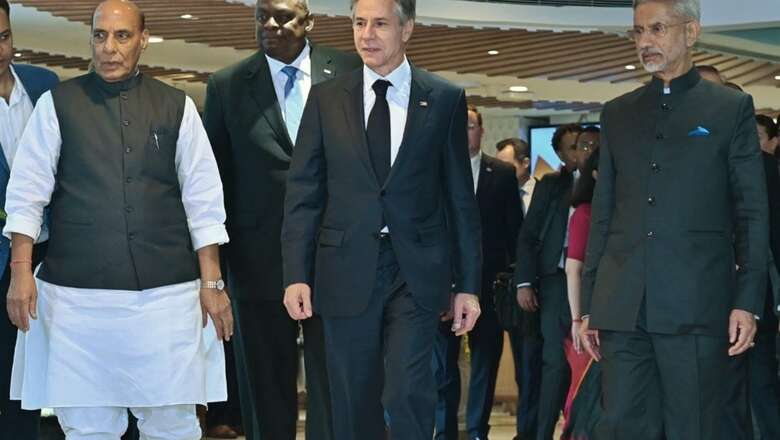
views
The timing of the India-US 2+2 Ministerial Dialogue on November 10 has sent its own political message. That both the US Secretary of State and the US Defence Secretary did not postpone the meeting despite their preoccupation with the dangerous situation developing in West Asia shows the importance the US attaches to maintaining the momentum of growing ties with India.
The US has moved two aircraft carrier groups and a Marine unit into the eastern Mediterranean both to deter Hezbollah from opening a northern front against Israel in connivance with Iran and to take military action if required. The US is already involved in a conflict over Ukraine with Russia in Europe. A potential conflict in the Western Pacific with China is brewing. On top of these two, the US is now facing a serious possibility of getting embroiled militarily in a third area of conflict, in West Asia.
India has stakes in all these conflicts. Its ties with Russia remain very important for bilateral and geopolitical reasons. These have come under pressure from the West because of the Ukraine conflict. In West Asia, India has critical energy, financial, manpower and geopolitical interests with the Arab countries, while also developing very substantial ties with Israel, to the point of opening up real possibilities of India-Arab-Israel cooperation in the region. India’s relations with China have become adversarial, just as US-China relations, creating a strong basis for a close partnership to counter China’s expansionist rise and its hegemonic ambitions.
In this background, other than the consolidation of India-US bilateral ties, the 2+2 Dialogue assumed timely importance.
The US has been reaching out to China in recent months with the declared intention to manage the increasingly adversarial relationship by putting guard rails in place to avoid the eruption of an actual military conflict. It has now been announced that a Biden-Xi meeting will take place in San Francisco at the time of the APEC summit there. There has been intensive planning for this meeting, with a spate of high-level US visits to China in advance. This too makes the timing of the 2+2 Dialogue significant.
If, on the one hand, the US sends signals of constructively engaging China within a defined strategic matrix, a signal is also being sent to China through the 2+2 Dialogue in advance of the Biden-Xi meeting that the Indo-Pacific strategy, the Quad and the strengthening ties with India in the context of China’s assertiveness remain a cornerstone of US strategy in Asia.
The joint statement issued on the occasion of the 2+2 Dialogue emphasises “the important role of the Quad as a force for global good for the peoples of the Indo-Pacific”. It looks forward to India hosting the next in-person Quad Leaders’ Summit in 2024, but this will hinge on President Biden attending the R-Day celebrations as Chief Guest.
It is noteworthy that Defence Minister Rajnath Singh stated during his bilateral meeting with his US counterpart that India and the US are increasingly in agreement on key issues, such as countering China’s aggression. The US Defence Secretary, in his media briefing, stated that both sides talked about the rising security challenges that are posed by China.
For the US it would have been important that Ukraine figured in the joint statement, as its omission would have been interpreted as declining US focus on Ukraine in view of the conflict emerging in West Asia (referred to as the Middle East in the joint statement). For India, it was a question of remaining within the bounds of its established position, especially as doubts have arisen in the US, Europe and Ukraine itself about external support for sustaining the conflict. The joint statement limits itself to the humanitarian consequences of the Ukraine conflict, and its impact on the global economic system, predominantly on the Global South. Rather prematurely, the joint statement speaks of post-conflict reconstruction in Ukraine. That would require ending the conflict first.
On Israel, both sides reiterated that they stood with Israel against terrorism, but also called for adherence to international humanitarian law, including with regard to the protection of civilians (a call obviously directed at Israel as a State and not Hamas as a terrorist outfit). While calling for an immediate release of all remaining hostages, the need for providing humanitarian assistance to meet the urgent needs of Palestinian civilians in Gaza has been stressed. The US, which opposes a ceasefire in Gaza and is only willing to support humanitarian pauses, has obtained India’s support for its position which is actually increasingly at odds with that of the Global South. At the Peace Conference organised by France on November 9 in Paris, President Macron’s position in support of humanitarian pauses “while working for a ceasefire” is one with which India could associate, because with the mounting civilian casualties in Gaza, especially of children, opposing a ceasefire is becoming politically untenable.
India has to take note of the hardening position of the Arab world on the conflict and find some common ground with it, without going as far as the declaration of the Arab/OIC summit in Riyadh which, besides calling for a ceasefire, urges the International Criminal Court to investigate “war crimes and crimes against humanity that Israel is committing” in Palestinian territories. The UN Secretary-General has also urged an immediate ceasefire.
Despite the uncertainties that have developed in West Asia with the Israel-Gaza conflict and its highly negative fall-out in the Arab/Islamic world, the joint statement nonetheless has rather optimistically “appreciated the ongoing efforts of the I2U2 countries to enhance food and energy security and improve the movement of people and goods across hemispheres”, besides also noting “that the India-Middle East-Europe Economic Corridor will enhance connectivity between Asia and Europe and will unlock new potential for economic growth in the two continents”.
On the defence side, the joint statement reaffirms the commitment to further deepen the multifaceted defence partnership through military exercises of increasing complexity and sophistication, accelerated joint projects initiated under the June 2023 Roadmap for India-US Defence Industrial Cooperation and expanded collaboration in emerging domains, such as space and artificial intelligence. The progress in cooperation in Maritime Domain Awareness is noted, with a decision to explore technology sharing to meet various maritime challenges, including in the undersea domain. The last is an area of special interest to India in view of the increasing movement of Chinese naval presence in the Indian Ocean.
The joint statement notes that negotiations for a commercial agreement between General Electric (GE) Aerospace and Hindustan Aeronautics Limited (HAL) to manufacture GE F-414 jet engines in India have begun. India is interested in co-developing and co-producing ground mobility systems (the Stryker infantry combat vehicle with radar capability carrying javelin missiles for which the US has made an initial offer). India is interested in further developing its maintenance, repair and overhaul (MRO) sector, encompassing aircraft maintenance and mid-voyage repair of US naval vessels.
The finalisation of a Security of Supply Arrangement (SOSA) to facilitate the integration of the defence industrial ecosystems of both countries while strengthening supply chain resilience is viewed as important.
The India-US Defence Acceleration Ecosystem (INDUS-X), launched in June 2023, had its first Investors Strategy Session in New Delhi just before the 2+2 Dialogue. This initiative is aimed at mobilising capital for funding innovation in cutting-edge technology.
The rapid progress made under the India-US Initiative on Critical and Emerging Technology (iCET) to build science and technology and critical technology value chain collaborations in both the commercial and defence sectors has been noted in the joint statement, with the second iteration of iCET in New Delhi planned in early 2024.
All these plans to expand cooperation in the defence sector hinge, however, on the US easing its export controls and technology transfers, the dialogue on which is conducted within the Strategic Trade Dialogue and its affiliated working groups.
The US sees interoperability as essential for credibly deepening its defence ties with India. This is predicated on supporting each other militarily in crisis situations. Interoperability is increasing in the naval and air force domains but not as much as in the land domain. Further discussions to maximise the shared benefits of the Logistics and Exchange Memorandum Agreement (LEMOA) are taking place. On land, India prefers to deal with the China challenge essentially on its own and has the confidence to be able to do so.
Space collaborations are being strengthened by establishing a fifth sub-working group, under the India-US Civil Space Joint Working Group, to focus on ‘Space Commerce’. The recently held Mineral Security Partnership Principals’ Meeting in London aimed at catalysing public and private sector investment to build diverse, secure and responsible global critical mineral supply chains has been noted positively in the joint statement.
On bilateral trade, the ministers noted that it has the potential to cross $200 billion in 2023. The next ministerial Trade Policy Forum and Commercial Dialogue meeting is planned for early next year.
With India opening a consulate in Seattle, the US plans to open consulates in Bengaluru and Ahmedabad.
By all accounts, the Dialogue went off very well, with a good understanding on virtually all the issues on the table. It would appear that the US was forthcoming on issues of interest to India, and was willing to open doors to the extent that India was prepared to walk through with its own ambitions and limitations.
Kanwal Sibal is a former Indian Foreign Secretary. He was India’s Ambassador to Turkey, Egypt, France and Russia. Views expressed in the above piece are personal and solely that of the author. They do not necessarily reflect News18’s views.




















Comments
0 comment